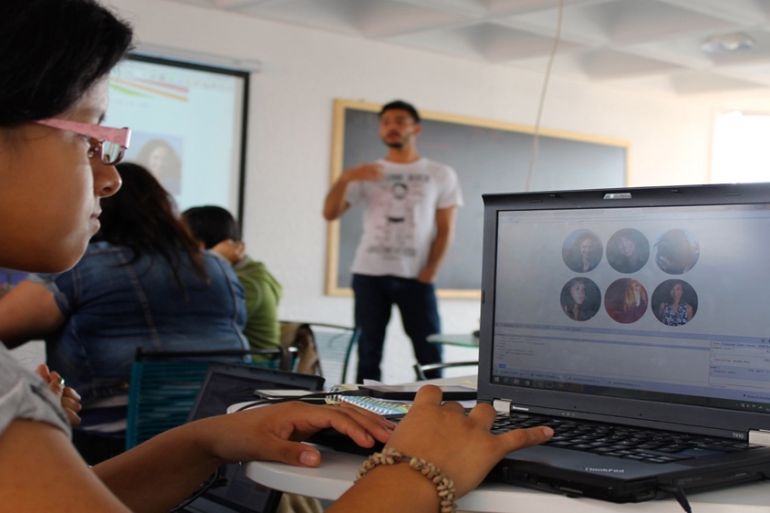Peru’s code-breaking women
New social enterprise has young women from poor areas of Lima eyeing jobs in Peru’s burgeoning technology sector.

Lima, Peru – Within the walls of an elegant 15-storey tower in Peru’s capital, dozens of young women zealously tap away at laptops, unmoved by the shimmer of the Pacific Ocean sifting through giant windows.
They’re not here for sea views, but for a four-month primer in software development. Hailing from the underprivileged margins of Lima, the 35 students in the class – all female – are taught JavaScript, CSS, and English-language programming terminology for a fee of $16 a month.
Keep reading
list of 4 itemsHong Kong’s first monkey virus case – what do we know about the B virus?
Why will low birthrate in Europe trigger ‘Staggering social change’?
The Max Planck Society must end its unconditional support for Israel
Named La Laboratoria – Spanish for “the laboratory” – the social enterprise hooks up young talent with firms in Peru’s burgeoning tech sector. It offers another option for students left out of the country’s education system, where private higher education is expensive, and its public equivalent is often mediocre and crowded.
Though less than a year old, La Laboratoria has already wooed more than $150,000 in grants from sponsors such as Google and telecom firm Telefonica. This year, it expects to teach about 100 young women whose average age is 20.
La Laboratoria gives us other opportunities to learn. All of us here are going to go very far.
Mirella Acelo is a 17-year-old from the Villa El Salvador shantytown, where many households aren’t connected to the power grid and lack running water. But she is a bright coder.
“My family has few resources and couldn’t afford to pay for a top institute, university, or my studies, really,” Acelo told Al Jazeera while typing.
“La Laboratoria gives us other opportunities to learn. All of us here are going to go very far.”
For Gabriela Javier, 21, who leaves her home in Ancon at 5:30am to make the three-hour journey to La Laboratoria in the upscale Miraflores district, the opportunity was “priceless”.
“It’s a sacrifice but you know you are going to be rewarded,” Javier told Al Jazeera.
Filling the skills gap
Nine in 10 young Peruvians from poor households lack access to quality education, according to Grade, a Lima-based think-tank. Of the one-in-five young people in Peru who neither work nor study, 70
percent are women, the International Labour Organization reported.
That consigns many of them to low-paid, informal labour, said 28-year-old entrepreneur and La Laboratoria founder Mariana Costa. But that could change with the emergence of Peru’s tech sector.
Costa, a poised Columbia University graduate with four years of work experience in the United States, explained that in the tech industry, university degrees aren’t always necessary for success. Self-taught
applicants often beat out computer science university graduates for jobs.
“Part of our value is that we connect girls with businesses,” said Costa.
“For a girl from the [outskirts] of Lima, it’s very difficult to get set up in a software firm. Where would you even start?”
Costa said she hopes the students will be able to fill the yawning skills gap faced by Peru’s surging technology industry – valued at $350 million, according to Peruvian software producers association Apesoft – as vacancies abound for software engineers and experienced designers.
The software development industry is expected to employ about 1.2 million people in Latin America and the Caribbean by 2025, making it the fastest-growing profession, according to the Inter-American Development Bank.
But, in line with global figures, just 7 percent of Peru’s tech-industry employees are women, according to a 2014 Mozilla Firefox survey.
La Laboratoria tackles this gender gap head-on, creating networking opportunities and ensuring that alumni leave with a solid portfolio of work.
Mind power, not manpower
Apesoft has set up a feeder programme to link its 80 members with La Laboratoria graduates, while
industry leaders from firms such as Microsoft give weekly talks, serving as networking opportunities.
“The industry isn’t run on manpower, but mind power,” said Juan Jose Miranda, Apesoft’s president. Women are an underused pool of talent, he explained, and often approach software problems from different perspectives than those of their male counterparts.
Peru’s software industry has experienced an “awakening” in the past five years, said Toni Del Rio, a Peruvian who is now a senior product manager at Amazon in Seattle.
But, she added, the “flywheel will only spin if we have a good quantity and quality of technical talent”. Initiatives such as La Laboratoria have been vital to igniting growth in Peru, Del Rio said.
The Andean nation could become a regional hub if the government targets the industry with certain incentives, said Miranda of Apesoft. Peru’s tech sector, which has been expanding between 10 and 15 percent a year since 2009, could help to boost the country’s exports.
The development of Peru’s telecommunications sector is undergirding that growth.
|
|
| Peru labour laws protests |
Internet penetration reached 39.2 percent of the population in 2013, a more than a five-fold increase over the past decade, according to International Telecommunications Union.
Meanwhile, the number of smartphone users grew to reach 3.4 million in 2013, said telecoms regulator Osiptel.
‘Breaking the hierarchy’
But much work remains. A large number of overlapping IT degrees at Peru’s universities confuses potential employers, and should be streamlined into the five core categories of computer science, computer engineering, software engineering, information technology, and information systems, said Miranda.
He added the government should help to fund start-up companies with the aim of growing the country’s tech industry.
As a mark of La Laboratoria’s potential, the start-up is expanding to the southern Peruvian city of Arequipa this year, and to Chile in 2016.
“As women, we’re not in the same league as men who have had more opportunities in programming,” Mabel Huayanay, 20, told Al Jazeera.
“But with La Laboratoria, we’re breaking the hierarchy.”